Skin Allergy: Types, Symptoms, Causes, Diagnosis, and Treatments


The skin, the body's largest organ, acts as a shield between the insides and the outside. However, it is not completely tough and reacts badly to things, causing skin allergies. Skin allergies are common and make life uncomfortable by showing up in different ways. This article talks about skin allergies, including types, symptoms, reasons, how doctors diagnose, and treatments. It explains terms like allergic reaction rash, skin rash, and allergy on the skin to help to understand better.
An allergic reaction rash shows up when the immune system reacts to something it thinks is bad, like an allergen. The immune response releases chemicals that make blood vessels expand, causing redness, swelling, itching, and discomfort. The rash are hives or eczema and appears anywhere on the body.
A skin rash means a clear difference in how the skin looks or feels. Rashes happen because of infections, allergies, the body's own defences, or things around the body. Remember, not every rash comes from allergies. They have different reasons. Rashes look like red spots, raised bumps, blisters, or scaly patches. Sometimes, they itch, hurt, or burn, depending on why they are happening.
Skin allergies happen when an allergen affects the skin. Skin allergies makes the immune system react, causing allergic reactions on the skin. These show up as redness, itching, hives, eczema, or other irritations. Things like metals (nickel), cosmetics, perfumes, latex, plants like poison ivy, and certain medicines cause skin allergies.
Skin allergies cover various conditions, each with unique features. Eczema, which is called atopic dermatitis, is long-lasting and makes the skin dry and itchy. It's often due to genes and the things around us. Contact dermatitis happens when skin touches something that irritates or causes allergies. This leads to redness, itching, and swelling in that spot. Urticaria, or hives, is another type of skin allergy with itchy raised bumps from histamine release.
Skin allergies have different symptoms, usually showing as redness, itching, swelling, and rash-like look. Sometimes, blisters and oozing sores happen. Skin allergies happen for many reasons, like genes, touching allergens or irritants. Things like humidity, temperature shifts, and certain chemicals make symptoms worse. Finding what causes a skin allergy is vital for good control.
Getting the diagnosis right is important for treating skin allergies. Dermatologists use a medical history, exams, and tests to find the cause. For contact dermatitis, they use patch tests, adding a bit of allergens on the skin. Blood tests that measure IgE antibodies help find allergies.
Skin allergy treatment wants to ease symptoms, control flare-ups, and stop more reactions. This means changing how a person lives, like avoiding things that aggravate it and using gentle products. Doctors often prescribe creams with corticosteroids and antihistamines to calm inflammation and itching. In bad cases, they suggest drugs that weaken the immune system or biologic therapies. It's best to talk to a healthcare pro for advice on what's right for a particular case.
Skin allergies encompass various conditions that greatly affect one's well-being. Accurate diagnosis and effective treatment require a thorough understanding of allergic response rashes, skin rashes, and skin allergies. Acknowledging kinds, signs, triggers, diagnostics, and treatments helps people pursue healthier skin and better life. Consult a doctor regarding the diagnosis and treatment of skin allergies according to the situation.
Skin allergies, scientifically called allergic contact dermatitis, happen when the skin reacts too much to things it touches. This makes the skin red, swollen, itchy, and sore. This kind of reaction is called delayed hypersensitivity, where symptoms show up hours to days after touching the trigger. Skin allergies come about when the immune system treats something as bad, even if it's not bad for most people. This immune response involves certain T cells and other immune cells, releasing things that make the skin inflamed and bad.
Allergic disorders, such as anaphylaxis, hay fever, eczema and asthma, now afflict roughly 25% of people in the developed world, explained by a Stanford University School of Medicine study.
An allergic reaction rash refers to a skin rash triggered by an allergic response. People who easily get allergies get a rash when they touch an allergen. This makes their immune system release stuff like histamines. These chemicals make the skin puff up and create a rash with redness, bumps, or blisters. The rash either stays in one spot or moves to other body parts.
A skin rash involves visible changes in the skin's appearance, texture, or colour. It occurs due to various factors such as infections, allergies, irritants, autoimmune problems, or other health issues. Rashes can look different – redness, swelling, bumps, blisters, dryness, scaling, or oozing. They cause itching, pain, or discomfort. Keep in mind, not every rash comes from allergies. Some have different causes. Other factors are involved, necessitating the identification of the specific cause for appropriate treatment and management strategies.
Skin allergies happen because the immune system and things outside, called allergens, interact. Allergic contact dermatitis mainly involves a kind of immune reaction called T cells. This reaction includes specialised immune cells called dendritic cells showing allergens to sensitised T cells. There is much research about this, like the study by Martin et al. in 2003, showing how T cells cause allergic contact dermatitis.
Things that cause skin allergies are different, like metals (nickel), perfumes, preservatives, latex, and plant stuff (like poison ivy). A big study by Thyssen et al. in 2010 talks about how often contact dermatitis happens and what causes it. This research helps to learn about the many things that cause skin allergies.
Skin allergies cause redness, itching, swelling, and sometimes blisters and sores. Immune cells, like mast cells and T cells, let out things like cytokines, histamines, and leukotrienes that make skin react. A study by Akdis and Akdis in 2011 looks at how these immune parts cause the usual symptoms of allergic contact dermatitis.
Doctors use different ways to diagnose skin allergies, like patch testing. This means putting a bit of allergens on the skin to see if there's a reaction. A study by Rustemeyer et al. in 2016 shows how good and useful patch testing is for finding allergies.
A skin allergy is when the skin reacts to certain things because of the immune system. This makes the skin red, swollen, itchy, and sore because immune cells act up and release things that cause inflammation. Plenty of research about the immune system, allergy triggers, and diagnosis methods helps us manage skin allergies effectively.
"Allergic Contact Dermatitis" is another way to say skin allergy. This means the skin reacts when it touches something it's allergic to, causing redness, itching, and other symptoms. This type of reaction happens later and is caused by the immune system. Doctors and researchers use the term "Allergic Contact Dermatitis" a lot in medical writing and when seeing patients. This name shows that skin allergies happen when the skin touches something it's allergic to, causing an immune reaction.
A study by Basketter et al. in 1993 looks into how allergic contact dermatitis happens and how it's different from other skin problems. This research shows that contact with allergens is important for getting this condition. This supports using "Allergic Contact Dermatitis" to talk about this skin allergy. "Allergic Contact Dermatitis" is another way to say skin allergy, focusing on the immune response when skin touches allergens. It's based on science and helps with diagnosing, managing, and talking about skin allergies.
Dermatologists and allergists often use "Allergic Contact Dermatitis" when they talk about skin allergies from touching allergens. They use it to tell this kind of dermatitis apart from other problems that might look similar but have different reasons. This term helps explain why patch testing is needed, which is a common way to find out which allergens cause the allergy. For example, if someone's skin gets red, itchy, and swollen from wearing nickel jewellery, doctors might say they have "Allergic Contact Dermatitis" because of nickel. This diagnosis helps decide treatment, like not wearing things with nickel and using creams to feel better.
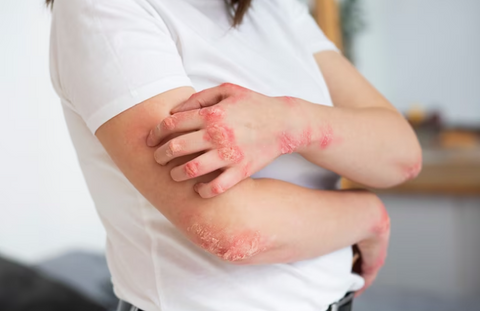
Image Description: This image displays a detailed look at a person's hand with a clear rash from allergic contact dermatitis. The red and swollen part has small raised bumps. The skin looks inflamed and irritated, with clear signs of itching as some parts are scratched and slightly broken. The rash feels bumpy and uneven, with dry patches and a bit of scaling. This image is a common example of allergic contact dermatitis, showing how the skin reacts when irritated.
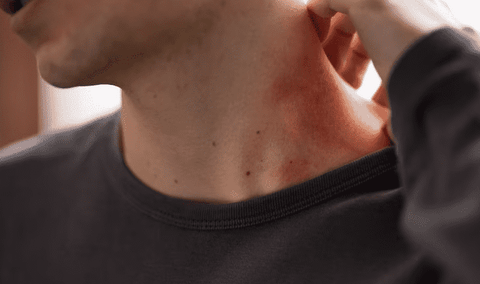
Image Brief Description: The image shows a person's hands with atopic dermatitis, called eczema. The skin of hands is red, inflamed, and irritated. It's dry and rough, with small raised bumps. The affected spot might look scratched, and in serious cases, there are signs of oozing or crusting. This lasting skin issue often affects places like elbows, knees, hands, and the face, causing strong itching and discomfort. Eczema's seriousness differs, so taking care of the skin and getting medical help are vital to manage symptoms and stop it from getting worse.
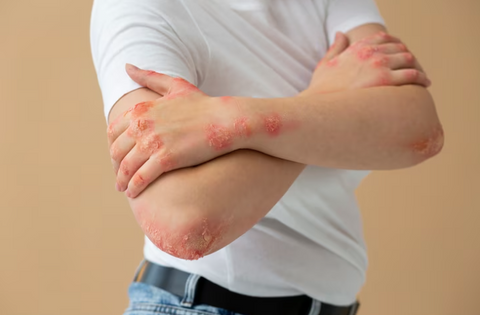
Image Brief Description: The image shows skin with urticaria, known as hives. The skin has red, raised bumps of different sizes and shapes. These bumps are a bit higher than the surrounding skin and are red or pink. The affected spot looks inflamed, and some bumps are paler in the middle. The hives are in a bunch on the skin, and the look tells it's an allergic reaction. This rash usually itches and happens because of allergens, medicines, or other things.
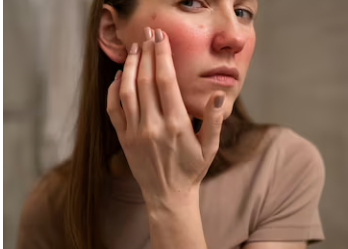
Image Brief Description: The image shows a part of swollen skin called angioedema. The red, raised, and inflamed look is there. Swelling goes under the skin, making it puffy. The skin's feel changes due to the swelling, and it might look a bit shiny. This image is a common example of angioedema, which usually comes from allergies or other health issues. If angioedema seems likely, it's crucial to get medical help to diagnose and manage it correctly.
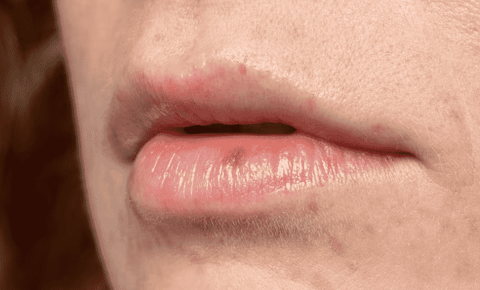
Image Brief Description: The image shows lips affected by allergic contact cheilitis up close. The lips are red and swollen, with clear inflammation along the lip's border. The skin is a bit rough, and there are small bumps or hives there. The swelling is easy to see on the upper and lower lips, making their usual shape look different. This allergic reaction is known for being in one spot and the clear redness and swelling, which are common signs of inflammation in the sensitive lip area.

Image Brief Description: The picture shows an affected area with a special rash from photoallergic dermatitis. The skin there is red and inflamed, with small bumps called hives or wheals. The rash forms an uneven pattern, showing it's because of an allergen set off by sunlight. The skin looks annoyed and itches, and there's a clear difference between the rash area and the normal skin around it. This image shows how photoallergic dermatitis looks, where an allergen (often from skincare things) becomes reactive under sunlight, causing an irritated rash.
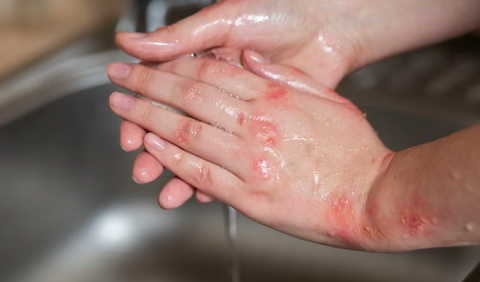
Image Brief Description: The image shows an affected area with a rash from phytophotodermatitis. The skin is red, inflamed, and has small blisters. The rash matches the pattern of contact with a certain plant or its juice that has stuff making the skin sensitive to light. The skin around it looks fine, showing the reaction's only in that spot. This image shows the usual signs of phytophotodermatitis, like redness, blisters, and inflammation, which happen after sunlight exposure.
The duration of a skin allergy differs based on the person, the allergen, and the reaction's severity. Mild allergies like rashes might last hours to days, while more intense reactions, like contact dermatitis, continue for weeks untreated. The actual duration of a skin allergy varies depending on the person, allergen, and reaction intensity. Mild allergies last hours to days, while contact dermatitis persists for weeks. Factors include immune response, allergen type, and skin reaction.
Medical sources confirm this variation in skin allergy duration. Mild reactions usually have brief symptoms. For example, hives last several hours to a day before fading, as per the "American Family Physician" study. Mild allergies, like temporary rashes or itching, often resolve fast. Hives, a common reaction, typically vanish within a day or two, per the "American Family Physician" journal.
Persistent skin allergies, like allergic contact dermatitis, endure if allergen exposure continues. Contact dermatitis lasts for several weeks, especially if the allergen is not identified and avoided, as reported by The Journal of Cutaneous and Aesthetic Surgery.
Allergic contact dermatitis, characterised by a delayed immune response to allergens like metals or chemicals, persist for weeks if the allergen isn't identified and avoided. The "Journal of Cutaneous and Aesthetic Surgery" research states that contact dermatitis lasts for two to four weeks or even longer, depending on individual sensitivity, the allergen, and treatment effectiveness.
Individual reactions to skin allergies vary, emphasising the need to consult a healthcare professional for accurate diagnosis, treatment, and symptom management. For precise duration and effective management, seeking advice from a healthcare provider is advisable. Their personalised guidance considers the specific allergy, triggers, and the most suitable steps for relief and recovery.
Different types of skin allergies include dermatitis, eczema and hives. Certain things cause them, like allergens or how the body's defences react. The common types of skin allergies include:
Allergic Contact Dermatitis: This skin allergy happens when skin touches an allergen. It makes the body's defences react. Things like metals (like nickel), makeup, smells, latex, and plants like poison ivy cause it.
Irritant Contact Dermatitis: Irritant contact dermatitis is not caused by allergens. It's when skin touches harsh things. No immune reaction, just irritation. Like strong chemicals, soaps, and solvents cause it.
Atopic Dermatitis (Eczema): Eczema, called atopic dermatitis, is a lasting skin issue. Skin gets dry, itchy, and red. We're not sure why, but genes and how the body defends itself play a role. Things like allergens, stress, and environment make it worse.
Remember, some skin issues might look like allergies, but they come from different reasons. Proper evaluation and diagnosis by a healthcare professional are essential to determine the specific type of skin allergy and implement an appropriate treatment plan. If anyone has a skin allergy, see a doctor to find out and get proper care.
The common symptoms of skin allergies, known as allergic dermatitis, primarily affect the skin include:
It's important to note that the skin-related symptoms are common in skin allergies, allergic reactions affects other parts of the body and leads to systemic symptoms, such as:
If anyone suspects skin allergy or experiences any allergic symptoms, it is important to seek medical attention for proper evaluation, diagnosis, and appropriate management.
Sneezing, a runny nose, and a stuffy nose are symptoms of allergic rhinitis, which is called hay fever. Allergic rhinitis happens when the nose gets red and stuffy because the body doesn't like things like pollen, dust mites, pets, or mould. Sneezing is a forceful expulsion of air through the nose and mouth in response to irritation, while a runny nose involves the excessive production of clear, watery nasal discharge. But, a blocked nose comes when the inside of the nose gets bigger and makes more boogers, which makes the nose feel full.
Sneezing, a runny nose, and stuffy nose are not direct symptoms of skin allergies. Instead, these things are signs that anyone has allergic rhinitis, which happens when stuff in the air that they are allergic to makes that person feel this way. Skin allergies mostly bother skin and cause things like itchy red bumps (hives) or rashes on skin.
Knowing the difference between allergic reactions is crucial. Skin allergies cause skin problems. The allergic rhinitis messes with breathing, causing sneezing, a runny nose, and a blocked nose.
People who have skin allergies and allergic rhinitis are reacting to different bad stuff at the same time. Similarly, if a person is allergic to nickel, they are bothered by pollen. This causes skin and nose problems when anyone is around these things.
It's really important to know what each allergy does so doctors figure out what's wrong and treat it right. If anyone has both skin and nose problems, talking to a doctor helps find out what's causing it and give good treatment for each part of the problem.
Allergens, like pollen or pet dander, cause this inflammation when they touch the eyes.
The immune system releases histamines, which cause redness, itching, and watery discharge. Allergens like pollen, pet dander, dust mites, and irritants such as smoke or perfumes cause allergic conjunctivitis by touching the eyes. Histamines and other immune system chemicals inflame the conjunctiva, leading to redness, itching, and watery discharge.
Allergic conjunctivitis links with skin allergies due to a shared cause: hypersensitivity to allergens. Both conditions involve an exaggerated immune response, causing inflammation and discomfort. This connection relates to atopy, a genetic tendency to react to substances, leading to various allergic symptoms, including skin issues and conjunctivitis.
People with atopy are prone to diverse allergic symptoms, affecting skin, eyes, nose, and respiratory system. When allergens affect someone with a skin allergy, the immune response causing skin symptoms triggers allergic conjunctivitis. This condition typically presents with red, itchy eyes and watery discharge, and it occurs concurrently with skin allergy symptoms.
Gastrointestinal symptoms like abdominal pain, nausea, vomiting, or diarrhoea occur in allergic reactions. These symptoms involve abdominal discomfort, queasiness, vomiting, and watery stools.
Abdominal pain, nausea, vomiting, or diarrhoea aren't usual primary signs of skin allergies.
Despite this, exposure to allergens causing an immune response which leads to systemic reactions, results in gastrointestinal symptoms.
Skin allergies linking to gastrointestinal symptoms happen due to released inflammatory mediators, like histamines and cytokines, during allergic reactions. When the immune system detects a harmful allergen, it releases chemicals to combat it. These chemicals impact various body parts, leading to abdominal pain, nausea, vomiting, or diarrhoea.
Not everyone with skin allergies has gastrointestinal symptoms. The severity and occurrence of these symptoms differ among individuals. Gastrointestinal symptoms usually connect more to ingested allergens (food allergies) than skin contact allergens. Ingested allergens cause systemic reactions, affecting both the skin and the gastrointestinal system.
Swelling of the lips, tongue, or face is a medical symptom characterised by the enlargement or puffiness of these areas.It often happens due to increased fluid buildup and inflammation from an immune response, an allergic reaction, or other underlying reasons. Skin allergy causes swelling of the lips, tongue, or face due to the immune system's involvement. Contact with allergens like foods, medications, insect stings, or environmental triggers trigger an overactive immune response in people with skin allergies.
During an allergic reaction, the immune system sees the allergen as a threat and releases chemicals like histamines and other inflammatory mediators into the bloodstream. These substances make blood vessels wider and more permeable, causing fluid to gather in affected tissues. Soft tissues in the lips, tongue, or face swell when they come in contact with an allergen.The swelling spreads out, depending on how much contact and a person's sensitivity to the allergen.
Hives, rash, or itchy skin often happen in allergic dermatitis, a skin allergy. These symptoms show up suddenly as raised, red welts (hives) or irritated, inflamed patches. The skin gets intensely itchy, causing a strong urge to scratch. The rash's size and shape vary, appearing in specific or larger areas based on allergen contact.
Hives, rash, and itchy skin are typical indications of a skin allergy due to the immune system's excessive reaction to an allergen. When someone with a skin allergy touches or encounters an allergen, their immune system treats it as a threat and starts an inflammation.
This inflammation prompts the release of histamines and other chemicals, making blood vessels leak, leading to hives and raised, red welts on the skin. Moreover, inflammation and immune reaction cause a rash, changing the skin's look, feel, or colour. This rash might show up as red, swollen, and irritated patches, causing itchiness and discomfort.
Itching comes from histamines, signalling nerves to feel itchy. This strong itch leads to scratching, making the skin worse or spreading the rash.
These signs show that the skin touched an allergen and reacted badly. It's vital to find and avoid the specific allergen to handle skin allergies and prevent more reactions. Healthcare professionals diagnose and manage allergies, helping individuals know their triggers and ease symptoms for better skin health.
The phrase "allergic reaction small red itchy bumps on the skin" describes a common type of allergic response called hives or urticaria. Hives are red, itchy welts that appear suddenly due to histamines and other inflammatory substances from an allergen.
Hives are a common sign of skin allergies, frequently triggered by foods, medications, insect stings, or the surroundings. The red itchy bumps show up in one spot or all over and usually go away in a few hours to days. For severe or lasting hives or other allergic signs, it's important to see a doctor to find the cause and proper care. Immediate medical assistance is crucial for severe allergic reactions (anaphylaxis) causing breathing difficulties or swelling, as they are life-threatening.
Fatigue, irritability, or feeling unwell are common nonspecific symptoms in individuals with skin allergies. These symptoms encompass tiredness, discomfort, unease, mood changes, and irritability. These symptoms affect the whole body, not just the skin reaction site, and are known as systemic symptoms.
Fatigue, irritability, and feeling unwell are symptoms of a systemic reaction in skin allergies. The immune system releases chemical mediators, like histamines, when it detects an allergen as a threat. This immune response releases various chemicals, including histamines, into the bloodstream.
Histamines are important for the body's defences and are part of the inflammatory response in allergies. However, if there's an excess, they impact the entire body, not only the skin. This might make blood vessels wider, lower blood pressure, and increase fluid leakage, causing swelling in various body parts. These body changes make people with skin allergies feel tired and unwell due to the immune response to the allergen. Irritability and mood changes happen due to discomfort and the body's response to inflammation.
Fatigue and feeling unwell result from disrupted sleep due to intense itching and discomfort in skin allergies, leading to less sleep and lower quality. Keep in mind that fatigue, irritability, and feeling unwell is linked to skin allergies, but they are caused by other factors. If they continue or worsen, or if severe allergic signs like trouble breathing or facial swelling appear, get medical help right away. Getting the right diagnosis and managing skin allergies helps to reduce these systemic symptoms and enhance overall well-being.
Headache or sinus pressure refers to discomfort or pain in the head or around the facial sinuses. These air-filled spaces are in the facial bones. The intensity of this symptom varies and feels like throbbing, pressure, or fullness in the head or face.
Headache or sinus pressure are linked to skin allergies because the respiratory and immune systems are connected. When an allergen triggers a skin allergy, the immune system reacts with inflammation. This releases various chemicals, including histamines, into the bloodstream.
Histamines are important for the immune response, but they have their impact on blood vessels, including those in sinuses. When histamines bind to receptors in vessel walls, they make the vessels wider. This increases blood flow to sinuses, causing swelling and congestion. The congestion and inflammation lead to pressure or discomfort in sinuses, causing sinus pressure. Additionally, inflammation and congestion in the nasal passages and sinuses result in sinus headaches, felt as deep, aching pain around the eyes, forehead, or cheeks.
Skin allergies might not directly cause sinus pressure or headaches, but they make existing sinus issues worse, like allergic rhinitis (hay fever). Allergic rhinitis impacts nasal passages and sinuses, leading to symptoms like sneezing, runny or blocked nose, and sinus pressure.
Remember that headache or sinus pressure isn't a common symptom for all skin allergies. But for those prone to allergies or with sinus problems, allergen exposure must worsen or trigger these symptoms. If headaches or sinus pressure accompany other skin allergy signs like rash, itching, or hives, it might suggest an allergic reaction.
If anyone has ongoing or severe headaches, sinus pressure, or other skin allergy symptoms, the person must consult a healthcare professional for proper assessment and care. They find the cause of symptoms and suggest suitable treatments or prevention methods.
Anaphylaxis is a serious, potentially life-threatening allergic reaction that happens rapidly after allergen exposure. This intense immune response affects the entire body, causing a sudden, notable drop in blood pressure, narrowing of airways, and other systemic symptoms. Immediate medical attention is crucial for anaphylaxis, which is deadly without treatment.
Anaphylaxis is a potential symptom of skin allergy as it's an exaggerated immune reaction to an allergen, like other allergies. When someone with a skin allergy meets a sensitising allergen, their immune system overreacts, releasing chemicals like histamines and other mediators.
In skin allergies, the allergen frequently contacts the skin, leading to local reactions such as rashes, itching, and redness. Occasionally, the allergen enters the bloodstream, causing a systemic allergic response that impacts different organs and body systems.
Allergens are often linked to skin allergies, like specific foods, medications, insect venom, or latex, triggers anaphylaxis. For example, an individual with allergies to peanuts or shellfish experience anaphylaxis if they accidentally consume them. Similarly, medications or insect bites lead to both local skin reactions and systemic anaphylaxis in susceptible individuals.
People with known skin allergies must understand anaphylaxis risk and carry prescribed epinephrine auto-injectors (EpiPens). Swift epinephrine use is vital for anaphylaxis care, reducing symptoms and stabilising them until emergency help arrives.
Anaphylaxis is a severe allergic reaction, usually caused by skin allergy, causing systemic reactions beyond local skin ones. It emphasises the need to recognise and handle skin allergies to avoid life-threatening problems.
Yes, stress worsen skin allergy symptoms. Medical research extensively shows that stress affects the immune system and makes skin allergies worse. Stress has a known link to skin conditions. Various ways show how stress affects the immune system and makes the skin allergies worse.
Studies confirm stress-skin allergy link: One study in the British Journal of Dermatology found that stress aggravates irritation and worsen eczema in atopic dermatitis patients. In another study, the Journal of Investigative Dermatology found stress worsened allergic contact dermatitis symptoms. Journal of Allergy and Clinical Immunology found that stress affects hives' severity and frequency.
This evidence strongly backs stress as a trigger or worsening of skin allergy symptoms. If anyone faces skin allergies, stress management using relaxation methods, mindfulness, and seeking help from health experts helps reduce reactions. But, remember, stress isn't the only cause, and responses differ. For personal guidance and treatment on skin allergies, consult a healthcare professional.
Yes, anxiety worsens skin allergy symptoms. Like stress, anxiety affects the immune system and the body's inflammation, making skin allergies worse. Here's how anxiety adds to skin allergy problems:
Although less research exists on anxiety's direct connection to skin allergies, various studies show the link between psychological factors and skin issues:
In Acta Dermato-Venereologica, a study noted higher anxiety and worse eczema in atopic dermatitis patients. The Journal of the American Academy of Dermatology linked anxiety to severe psoriasis. Journal of Allergy and Clinical Immunology research found that stress exacerbated chronic hives, making episodes longer and more intense.
With this proof, handling anxiety is vital for those with skin allergies. Cognitive-behavioural therapy (CBT), relaxation routines, and mindfulness aid in lowering anxiety, enhancing well-being, and likely controlling skin allergy symptoms. If anxiety affects anyone and skin allergy symptoms arise, consult a healthcare professional for personalised help and guidance.
Yes, symptoms of skin allergies vary, based on the allergen involved. Skin allergies, or allergic contact dermatitis, occur when the skin touches an allergen that prompts an immune reaction. Various allergens lead to unique skin reactions. Here are examples of allergens and their linked symptoms:
Different reactions to allergens and varying symptoms are common. Skin allergies might extend beyond the contact area. If there's suspicion of a skin allergy with symptoms, medical attention is vital. An allergist or dermatologist uses patch testing to pinpoint the specific allergen, advise on trigger avoidance, and suggest effective management strategies.
Common causes of skin allergies include:
Keep in mind that the severity and frequency of skin allergies differ among people. Some are more sensitive to particular allergens, while others might not respond to them. If anyone thinks having a skin allergy or having skin allergy symptoms, consulting an allergist or dermatologist for proper assessment, diagnosis, and care is advisable.
Risk factors for skin allergies include:
Having risk factors doesn't guarantee skin allergies. Genetics, environment, and immune responses influence the chance of allergies. If worried or symptomatic, consult a healthcare professional for proper evaluation and management.
To diagnose a skin allergy, experts like allergists or dermatologists usually conduct a thorough assessment. This involves a detailed medical history, physical exam, and, if needed, tests to pinpoint the allergen behind the skin reaction
In the medical history check, the provider asks about symptoms, rash appearance, reaction timing, triggers, and allergy history. They inquire about work, hobbies, and exposure to potential allergens. The physical exam closely examines the affected skin and other relevant areas to understand the skin allergy's nature and extent. Providers search for patterns like redness, itching, swelling, hives, or distinct reactions.
When the allergy's cause isn't clear, the provider might suggest more tests. A common method is patch testing, where potential allergens are placed on the skin with patches. These stay for a set time, allowing the reaction to be observed. Patch testing pinpoint allergens causing allergic contact dermatitis. Additional tests involve blood tests for allergen-specific antibodies like Immunoglobulin E (IgE) or skin prick tests, where tiny allergen amounts are introduced under the skin using a small needle. These tests identify allergies to things like pollen, pet dander, or specific foods.
The American Academy of Allergy, Asthma & Immunology (AAAAI) and the American College of Allergy, Asthma, and Immunology (ACAAI) suggest patch testing as the primary method for diagnosing allergic contact dermatitis. Patch testing is a safe and effective way to find contact allergens, useful for various substances like metals, fragrances, and preservatives in everyday products. Research in the Dermatitis journal shows patch testing's importance in pinpointing allergens causing allergic contact dermatitis and guiding management. Note that patch testing requires trained professionals to avoid wrong results or skin irritation. A precise diagnosis helps manage skin allergies by avoiding allergens and relieving symptoms properly.
For diagnosing skin allergies, various tests are conducted. The usual tests used to pinpoint the allergen behind the skin reaction include:
Test selection depends on the suspected skin allergy type and the patient's situation. Allergists, dermatologists, or skilled healthcare professionals usually conduct these tests to diagnose and manage skin allergies. Accurately identifying the allergen causing the reaction is vital for crafting a fitting treatment plan and taking steps to prevent future allergen exposure.
No, blood tests aren't usually used to first diagnose skin allergies. These tests, like specific IgE testing, are common for allergies like pollen or pet allergies, but not for skin allergies. Skin allergies, called allergic contact dermatitis, happen from touching allergens, causing a reaction right where they touch.
Blood tests check for specific antibodies in the blood. But for skin allergies, the immune response happens on the skin, with sensitised T cells and other immune cells in that spot. This immune response doesn't mainly produce IgE antibodies in the blood, which blood tests usually look for.
Patch testing is a better way to diagnose skin allergies. In this test, tiny bits of allergens go on the skin with patches. The patches stay on for around 48 hours to see if a reaction happens where they touch. This test imitates how allergens touch the skin in real life.Therefore, blood tests are good for some allergies, but not for skin allergies. The best way to diagnose skin allergies is patch testing, where allergens touch the skin directly.
Allergic skin reaction treatment involves various methods to manage and alleviate symptoms. These treatments aim to reduce inflammation, relieve itching, and prevent allergic reactions. Here are some common treatments:
Avoiding allergens means staying away from things that cause allergic reactions. If one is allergic to pollen, it is better to stay indoors on high pollen days. It is because being exposed to pollen makes one sneeze or itch due to an allergic reaction.
Avoiding allergens works by reducing contact with substances that cause allergies. When one avoids contacting allergens, the body doesn't get a chance to react to them. It lowers the risk of allergies like sneezing, coughing, and skin rashes.
Avoiding allergens helps manage allergies. It reduces how often and how bad allergic reactions happen. Around 30-40% of people worldwide are affected by allergies, says the World Allergy Organization. Effectiveness varies among individuals and depends on the specific allergens. Some people easily avoid certain allergens. Others require help from a healthcare professional.
Topical creams and ointments are medicines applied directly to the skin. It comes in both creams and ointment forms. These creams are used for treating various skin problems.
Topical medications work when absorbed into the skin. Then it targets the affected area. It reduces redness, itching, and swelling. Topical treatments are the main way to manage lots of skin problems, according to The American Academy of Dermatology.
The effectiveness of the topical creams and ointments depends on the specific conditions. Some people find them helpful in relieving symptoms. Some others do not experience as much improvement. It's important to follow the complete instructions given by a healthcare professional while using these creams. Talk to a healthcare professional if the medication does not work and one still has some concerns.
Oral medications are medicines that are taken by mouth, like tablets or capsules. When one swallows oral medications, they travel through the body after being absorbed in the stomach. This helps them reach places where medications are required.
Oral medications work well to treat various conditions. Its effectiveness is determined by the medicine and the body's response. Around 47% of people in the U.S. take at least one prescription medication each month, as per the Centers for Disease Control and Prevention.
It's important to follow the instructions from a healthcare professional for oral medications. Take these medications at the right times and in the right amounts. This helps the medications work best.
Moisturisers stop the skin from drying out. They create a protective layer that locks in water, making skin smoother and less itchy. Moisturisers are great for preventing and easing dry skin. They work by keeping the skin hydrated, which reduces itching and discomfort.
The effectiveness of moisturisers depends on the product and the skin type. It is recommended to choose a moisturiser according to the skin type. One must consult a healthcare professional if having skin issues. They suggest the right moisturiser and give advice on keeping one's skin healthy.
Wet compresses involve using damp cloths or towels on the skin to provide relief. They are like wet clothes on the skin. It feels cool and soothing when applied to the skin. It makes the redness and itching go away.
Wet compresses are effective for reducing inflammation and discomfort in various skin conditions, as per the American Academy of Dermatology. Wet compresses help soothe irritated skin and make one feel better.
The effectiveness of wet compresses depends on the condition and the skin. One must use the right temperature and materials for the best results. Healthcare professionals guide on how to do it properly.
Immunotherapy is a treatment that helps the body get used to allergens over time.
Allergy shots have a small amount of allergens. As a result of these vaccinations, the body becomes accustomed to handling allergens. It makes allergic reactions less severe.
Immunotherapy provides long-term relief from allergy symptoms, according to the American College of Allergy, Asthma & Immunology. Over time, the body becomes less sensitive to allergens And one has fewer and milder reactions. Its effectiveness varies from person to person and it needs regular treatment.
Yes, skin allergy treatments are available at online pharmacies. Availability varies based on country, regulations, and pharmacy. Many countries' online pharmacies provide OTC medicines and topicals to handle mild to moderate skin allergy symptoms. Common skin allergies like allergic contact dermatitis or other irritation are treated with things that are bought without a prescription. Online pharmacies have topical corticosteroids, antihistamines, and soothing creams. These medicines help with itching, redness, and swelling from skin allergies.
Online pharmacies often offer these treatments and medications for skin allergies:
Buying medicines online requires caution. Pick licensed, trustworthy online pharmacies for genuine products. Read descriptions, verify ingredients, and follow recommended dosages and usage. OTC meds help mild to moderate skin allergies, but severe or ongoing cases need prescribed medicines or special treatments. If severe symptoms persist or OTC doesn't work, consult an allergist or dermatologist. They'll give personalised advice and treatment based on needs and medical history of the patient.
Yes, some home remedies ease mild skin allergy symptoms. But remember, these don't replace professional advice, especially for severe cases. If unsure about the cause or if severe, consult a healthcare professional for proper evaluation and treatment.
Below are home remedies for mild skin allergy relief:
Remember, home remedies need care. Some natural items might trigger allergies or worsen irritation in certain individuals. Test on a small area of skin before use. If symptoms continue, worsen, or get severe, consult a healthcare expert. They'll assess and suggest proper treatment based on the situation.
To prevent a skin allergy, follow these key methods and steps:
Follow these precautions and notice the body's reactions to greatly lower skin allergy risk, leading to healthier skin.
No, skin allergies aren't usually hereditary in families like "Hereditary Angioedema (HAE)" is. Hereditary Angioedema (HAE) is a particular type of skin allergy with a genetic origin. It's important to differentiate HAE from other common skin allergies, such as allergic contact dermatitis or atopic dermatitis (eczema has a significant genetic link.
Hereditary Angioedema (HAE) is an inherited condition due to gene mutations affecting proteins like C1-inhibitor in the blood. These mutations lead to C1-inhibitor deficiency or dysfunction, causing unchecked activation of specific immune pathways.
This strange reaction causes fast, bad swelling (angioedema) in places like the skin, face, lips, tongue, and throat. Importantly, HAE mainly affects the deeper skin layers and mucous membranes, unlike other common skin allergies that impact the more surface layers.
Various skin allergies, such as allergic contact dermatitis and atopic dermatitis, are often complicated problems affected by genes, surroundings, and how the immune system works. While a family history might heighten the risk of these skin allergies, genetics alone don't determine their occurrence.
Skin allergies, like allergic contact dermatitis or hives (urticaria), aren't usually inherited in a clear genetic way. These usually happen because of how a person's immune system reacts to things nearby. But, if allergies or atopic issues (such as asthma, hay fever, or eczema) run in the family, the odds of getting skin allergies go up because the family has a tendency for allergic reactions. Even though genetics affect how likely someone is to get allergies, it's not the same as direct inheritance seen in conditions like Hereditary Angioedema (HAE).
Hereditary Angioedema (HAE) is a rare genetic problem that causes serious swelling under the skin and inside. It's from changes in specific genes, like the SERPING1 gene. HAE is directly passed down in families and follows a clear genetic way. If a parent has HAE, their kids have a 50% chance of getting it too.
On the other hand, regular skin allergies are more complicated in how they're passed down because of lots of genetic and outside factors. Having genes that increase the chance of allergies doesn't guarantee a specific allergy. Research, like a study in the "Journal of Allergy and Clinical Immunology" in 2010, shows that differences in genes related to the immune system cause allergies, but it doesn't always happen in a straightforward inherited way.
If there's suspicion of Hereditary Angioedema (HAE) or any other skin allergy in anyone or a family member, getting medical help is vital for accurate evaluation and diagnosis. Genetic testing and specialised medical assessments pinpoints specific hereditary skin allergies, aiding suitable management plans. Swift diagnosis and treatment are key to effectively handling hereditary skin allergies and lessening the chance of severe allergic reactions.
Skin allergies and skin rashes are common skin problems. They have different causes, characteristics, and treatments. It's important to know these differences to diagnose and manage them correctly.
Skin Allergy: A skin allergy, or allergic dermatitis, happens when the immune system reacts oddly to normally harmless substances. These substances, known as allergens, cause an allergic reaction when they touch the skin. Allergens include certain metals (nickel), plants (poison ivy), cosmetics, fragrances, latex, and certain medications. When skin touches an allergen, it shows redness, itching, swelling, and other signs.
Characteristics of Skin Allergies
Delayed Reaction: Skin allergies often have a delayed onset, with symptoms appearing hours to days after exposure to the allergen.
Swelling: Allergies cause swelling, which are limited or spread out, depending on how serious the allergy is.
Blisters: Blisters and hives (raised, itchy bumps) develop, especially in more severe allergic reactions.
Distribution: Allergies usually happen in certain areas where the skin touches the allergen.
Skin Rash: A skin rash is a general word for changes in how the skin looks, its colour, or texture. Rashes happen for different reasons, like infections, allergies, autoimmune issues, or things in the environment. The symptoms include redness, bumps, blisters, dry patches, or scaling. Rashes last for a short period of time or last for a long period of time, look different and be more or less severe.
Characteristics of Skin Rashes
Diverse Causes: Skin rashes come from many things, such as infections (like fungus or bacteria), ongoing skin problems (like eczema or psoriasis), allergies, or certain medicines.
Variable Symptoms: Skin rash symptoms vary, from slight itching and redness to serious discomfort, pain, and sometimes fever, based on what's causing it.
Varied Appearance: Rashes present as raised or flat, with different textures like scales, crusts, or pustules. They cover small or large areas of the body.
Rash Types: Certain rash types have clear traits, like eczema (itchy, inflamed skin), psoriasis (red, scaly patches), and contact dermatitis (skin reacts to something irritating or allergenic).
Differences Between Skin Allergies and Skin Rashes
Cause: Skin allergies happen due to an immune reaction to allergens, whereas skin rashes come from different reasons, including allergies.
Specificity: Skin allergies occur at the site of allergen contact, whereas rashes appear in various areas without direct contact with the trigger.
Underlying Factors: Skin rashes have infectious, inflammatory, autoimmune, or environmental origins, whereas skin allergies are rooted in an immune response to specific allergens.
Skin allergies and skin rashes are distinct yet interconnected concepts. Skin allergies directly include an immune reaction to allergens, causing itching, redness, and swelling, usually with a delayed start. Meanwhile, skin rashes cover different skin changes due to many factors, including allergies. Proper diagnosis and treatment require careful consideration of symptoms, timing, and potential triggers to address each condition effectively. If someone experiences persistent or severe skin issues, consulting a dermatologist is recommended for an accurate diagnosis and appropriate management.










Plus get the inside scoop on our latest content and updates in our monthly newsletter.